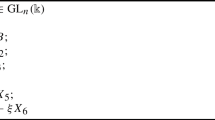Abstract
The algorithm detailed below extends previous work on inversion of block tridiagonal matrices from the Hermitian/symmetric case to the general case and allows for varying sub-block sizes. The blocks of the matrix are evenly distributed across p processes. Local sub-blocks are combined to form a matrix on each process. These matrices are inverted locally and the inverses are combined in a pairwise manner. At each combination step, the updates to the global inverse are represented by updating “matrix maps” on each process. The matrix maps are finally applied to the original local inverse to retrieve the block tridiagonal elements of the global inverse. This algorithm has been implemented in Fortran with MPI. Calculated inverses are compared with inverses obtained using the well known libraries ScaLAPACK and MUMPS. Results are given for matrices arising from DFT applications.
Access this chapter
Tax calculation will be finalised at checkout
Purchases are for personal use only
Similar content being viewed by others
References
Amestoy, P.R., et al.: A fully asynchronous multifrontal solver using distributed dynamic scheduling. SIAM J. Matrix Anal. Appl. 23(1), 15–41 (2001). https://doi.org/10.1137/S0895479899358194
Amestoy, P.R., et al.: Hybrid scheduling for the parallel solution of linear systems. Parallel Comput. 32(2), 136–156 (2006). https://doi.org/10.1016/j.parco.2005.07.004
Blackford, L.S., et al.: ScaLAPACK Users’ Guide. SIAM, Philadelphia (1997). https://doi.org/10.1137/1.9780898719642
Cauley, S., et al.: A scalable distributed method for quantum-scale device simulation. J. Appl. Phys. 101(12), 123715 (2007). https://doi.org/10.1063/1.2748621
Cauley, S., et al.: Distributed non-equilibrium Green’s function algorithms for the simulation of nanoelectronic devices with scattering. J. Appl. Phys. 110(4), 043713 (2011). https://doi.org/10.1063/1.3624612
Hager, W.W.: Updating the inverse of a matrix. SIAM Rev. 31(2), 221–239 (1989). https://doi.org/10.1137/1031049
Henderson, H.V., Searle, S.R.: On deriving the inverse of a sum of matrices. SIAM Rev. 23(1), 53–60 (1981). https://doi.org/10.1137/1023004
Hurst, D., et al.: NCAlgebra. Version 4.0.5 (2011–2017). https://github.com/NCAlgebra/NC
MUMPS Users Guide. http://mumps.enseeiht.fr/doc/userguide_5.0.1.pdf
Rocha, A.R., et al.: Towards molecular spintronics. Nat. Mater. 4, 335–339 (2005). https://doi.org/10.1038/nmat1349
Rocha, A.R., et al.: Spin and molecular electronics in atomically generated orbital landscapes. Phys. Rev. B 73, 085414 (2006). https://doi.org/10.1103/PhysRevB.73.085414
Rungger, I., Sanvito, S.: Algorithm for the construction of self-energies for electronic transport calculations based on singularity elimination and singular value decomposition. Phys. Rev. B 78, 035407 (2008). https://doi.org/10.1103/PhysRevB.78.035407
Wolfram Research, Inc.: Mathematica. Version 10.0 (2014). http://wolfram.com
Acknowledgements
All calculations were performed on the Boyle cluster maintained by the Research IT, Trinity College Dublin, Ireland, funded by Science Foundation Ireland.
Author information
Authors and Affiliations
Corresponding author
Editor information
Editors and Affiliations
Rights and permissions
Copyright information
© 2018 Springer International Publishing AG, part of Springer Nature
About this paper
Cite this paper
Spellacy, L., Golden, D. (2018). Partial Inverses of Complex Block Tridiagonal Matrices. In: Wyrzykowski, R., Dongarra, J., Deelman, E., Karczewski, K. (eds) Parallel Processing and Applied Mathematics. PPAM 2017. Lecture Notes in Computer Science(), vol 10777. Springer, Cham. https://doi.org/10.1007/978-3-319-78024-5_55
Download citation
DOI: https://doi.org/10.1007/978-3-319-78024-5_55
Published:
Publisher Name: Springer, Cham
Print ISBN: 978-3-319-78023-8
Online ISBN: 978-3-319-78024-5
eBook Packages: Computer ScienceComputer Science (R0)



